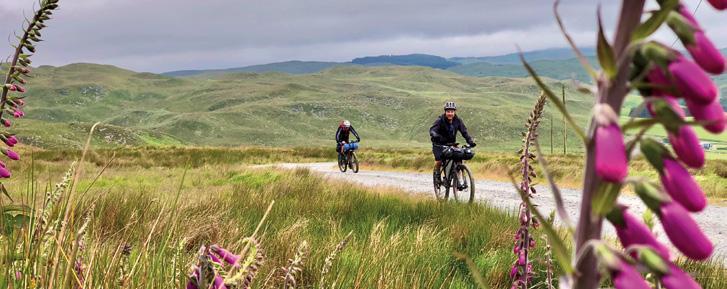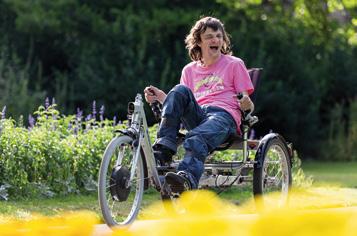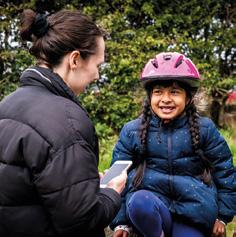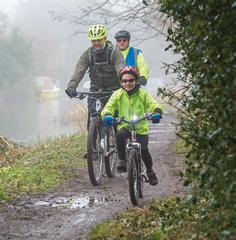Introduction
On 4 April 2019, Welsh Government announced, unequivocally, that it wanted more people to enjoy the countryside and that it was going to help them do it:
“…we are committed as a Government to enabling more people to enjoy our countryside more easily –to take advantage of the many health and wellbeing benefits that getting outside can bring.
“An accessible countryside supports our efforts to boost Wales as a tourism destination and a magnet for walkers, cyclists and thrill-seekers.”
Hannah Blythyn MS, then Deputy Minister for Housing & Local Government, 4 April
20191
The motivations behind this vision – health, well-being and tourism – came as no surprise, tallying perfectly with the economic, social, environmental and cultural goals of the Well-being of Future Generations (Wales) Act 2015.
The Minister’s resolve to reform countryside access did not come out of the blue either. Welsh Government had already surveyed public opinion twice, and the majority loved the idea:
• In 2015, the Government consulted on ‘Improving Opportunities to Access the Outdoors for Responsible Recreation’. Most of the 5,796 respondents said that, yes, they wanted more people to engage with the outdoors and nature in Wales.2
• About 70% supported Cycling UK’s (then CTC) and OpenMTB’s ‘Trails for Wales’ campaign, calling for radical reform to public access.3
• In 2017, the Government picked up the access thread once more and consulted the public on managing the country’s natural resources sustainably.4 Its proposal to enable cycling and horse riding on footpaths under the same conditions as those provided for cycling on bridleways under the Countryside Act 1968, s.30, attracted nearly 14,000 responses, the vast majority in favour (86%). Over half (7,375) were again inspired by our ‘Trails for Wales’ campaign.
By April 2019, Welsh Government had all the support it needed for its visionary changes to progress from concept to reality.
Recognising that “The complex nature of the existing legislation has been one of the triggers for reform”, the Minister commissioned an Access Reform Advisory Group (ARAG) to consider in detail “how the more significant changes to access rights should be implemented and the simplification of the recording, planning and changing of public access.”
Page 3
ARAG’s remit included looking at how to implement the following proposals:
• Multi-use paths (allowing cycling and horse riding on footpaths); and
• Reducing the restrictions associated with open access land.

The latter proposal was accompanied by this unambiguous statement: “We will lift the restrictions on cycling and horse riding, hang-gliding and para-gliding, bathing or using a vessel or sailboard on natural bodies of water.”5
If all the above weren’t ample grounds to believe that change was definitely on the way, and soon, in June 2021 the Programme for Government set well-being objectives for the next five years on healthcare, inequality, a greener economy, the nature emergency and tourism, all of which are complementary drivers for access reform.6
Yet Natural Resources Wales’ (NRW) reflections on ARAG’s discussions, appearing as a ‘Final Advice Report’7 in November 2021, can only be described as a dampener. Rather than making clear-cut recommendations, the report focussed merely on options, in effect watering down the Government’s bold and inviting vision of 2019.8
Both Cycling UK and OpenMTB, not to mention the thousands of people who’d supported our Trails for Wales campaign, found this deeply frustrating.
We’d sent representatives to all three of ARAG’s expert groups, advocating two changes to make it decidedly easier for people to enjoy the countryside actively by cycle:
• Lifting cycling restrictions on most footpaths by default, unless unsuitable (as opposed to the cumbersome and inefficient case-by-case process still in use today); and
• Allowing additional activities, including cycling, on all access land designated under the Countryside and Rights of Way Act (CRoW) 2000 (as opposed only to specific areas or linear corridors).

2
1 Welsh Government. Written Statement on taking forward access proposals. 4 April 2019
Welsh Government. Improving opportunities to access the outdoors for responsible recreation. 3 cyclinguk.org/trailsforwales 4 Welsh Government. Taking Forward Wales’ Sustainable Management of Natural Resources. 5 Welsh Government. Written Statement on taking forward access proposals. 4 April 2019 6 Welsh Government. Programme for government. 7 Natural Resources Wales. Access Reform Programme. 2021 8 Cycling UK. Trails for Wales: Access reform recommendations “disappointing”. 18 November 2021
24 Page 4
“At a personal and societal level the evidence is strong and growing that people tend to be happier, healthier, and more productive, creative, active and engaged in community and civic life when nature is a meaningful part of their lives. […] They are also more likely to care for it.”
Trails for Wales: We can’t afford to wait cyclinguk.org

As the findings of Cycling UK’s ‘Rides of Way’ survey suggest, opening up suitable footpaths is likely to transform cyclists’ experience of the countryside. Of the ten thousand plus respondents from across Britain:
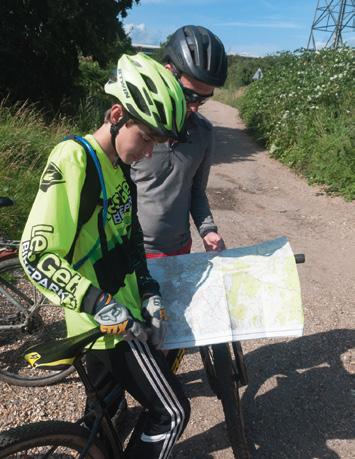
• Seven in ten said they could enjoy a greater variety of routes.
• Around two-thirds could “make better routes” and avoid busy roads.
• Almost half could ride more from home, and 37% ride more overall.9
And these were people who knew exactly what they were talking about, being mostly long-term, practised off-road riders, spending a good number of hours out on their bikes each week. Their knowledge of the difficulties and thoughts on how to overcome them could help inform improvements for all sorts of other riders, local or otherwise – families, children, and people with anything from a handcycle to a gravel bike.
But, of course, it isn’t just cyclists and cycling that would benefit from a more open countryside. Wales itself could reap significant rewards because active recreation is so good for public health and well-being, while revenue from outdoor tourism lifts the economy.
Again, this is no revelation for the Government. As far back as 2005, ‘Climbing Higher’, the Welsh physical activity strategy, said that CRoW:
“…opens up large areas of Wales for public access, the combined area of open country and registered common land in Wales is about 360,000 hectares, or about 20% of the land area of Wales. This offers significant opportunities for more active recreation in the countryside, as well as associated health, business and education opportunities.”10
And, fourteen years later on 4 April 2019, the Minister said Welsh Government wanted to open up the countryside much further for much the same reasons.
Regrettably, though, NRW’s ‘Final Access Report’ of November 2021 left the final decisions on visionary reforms hanging.
Since then, nothing has happened. No progress. No decisions. It’s been ready, steady but no go.
government waits any longer.
Cycling UK believes that Wales, its population and visitors, will start losing out if
Page 5
9 Cycling UK. Rides of Way. 2017
10 Welsh Government. Climbing Higher/ Dringo’n Uwch. 2005, p24.
About this report
This report’s purpose is to reignite Welsh Government’s stated, documented and much welcome commitment to open up the nation’s stunning natural environments to more people.
In the sections below, we reinforce the two main motivations behind this vision by looking into the rewards that getting outside and cycling in particular can bring for:
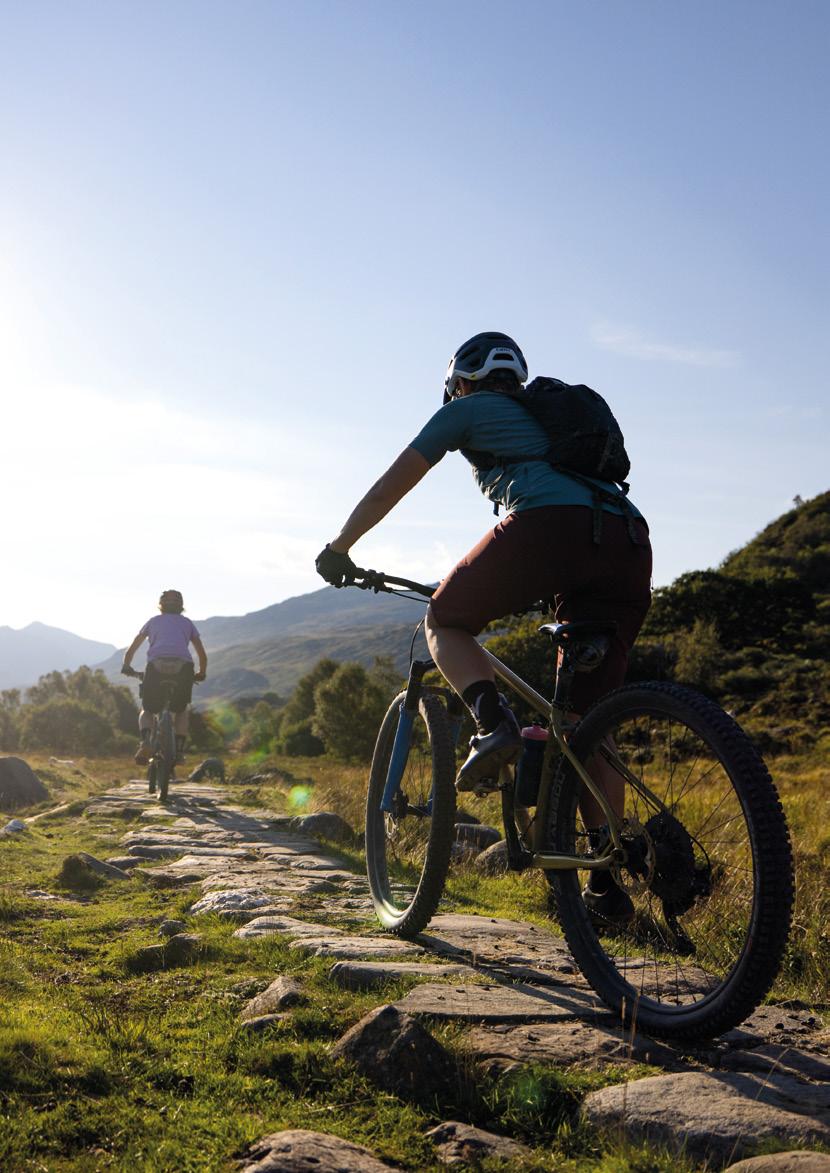
• Health and wellbeing
• Tourism
We then explain why all too many people currently find it difficult to explore the countryside actively, or even feel locked out of it, and how we believe this could be solved by tackling “the complex nature of the existing legislation” head-on, lifting restrictions on cycling and opening up CRoW access land to additional activities, including cycling.
Page 6
Trails for Wales: We can’t afford to wait cyclinguk.org
There’s hardly a healthier way to experience and engage with the countryside and its further reaches than cycling.
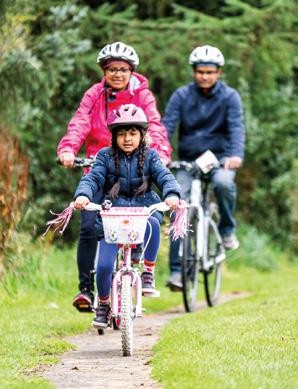
The physical inactivity emergency
Welsh Government will be only too aware of the physical inactivity emergency, but we must echo how serious it is and why incentivising people to exercise more often is so crucial:
In Wales:
1/3
of adults are classed as inactive (active less than half an hour a week), while 62% are overweight or obese11
Perhaps even more worryingly:
54% of children and young people aged 3-17 are active for less than an hour a day, seven days a week12
1/3
Among children aged 11-16, Wales has “…some of the poorest levels of PA [physical activity] and time spent in sedentary behaviour globally”13
On top of that, sedentary behaviour is a significant financial burden for the health service:
£35m
of primary school starters are overweight or obese14 £
Public Health Wales reckons that, in 2014/15, the NHS in Wales spent £35 million that year treating preventable diseases caused by physical inactivity15
1. Motivation one: taking advantage of the “many health and wellbeing benefits that getting outside can bring”
Page 7
Cycling off-road & the ‘natural health service’
Cycling’s potential to help activate more people physically – and save the NHS money – is clear.
According to the National Survey for Wales (NSW):16
• Cycling is the most popular outdoor activity that people said they would like to do more of; and
• After walking, cycling is the most popular outdoor pursuit.
And, as our ‘Rides of Way’ survey told us, those who do already cycle off-road regularly really feel the benefit:
90% of respondents rated off-road cycling as ‘very’ or ‘fairly’ important for their physical health
91% said the same about their mental health
2/3 reported that off-road cycling is their primary form of exercise17
and byways, and cycle there directly from the doorstep rather than driving.
In other words, serious cycle-trekking missions are one thing, but people especially enjoy making use of local rights of way to immerse themselves in the natural environment (if they can, that is).
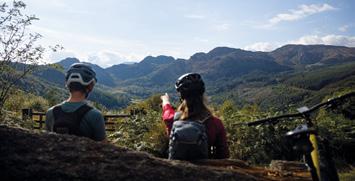
But perhaps our respondents’ personal stories say this even more persuasively. One told us:
“I have mild, well controlled COPD [chronic obstructive pulmonary disease], and find that cycling helps me […]. I am 79.”
Another said:
“Living on the edge of the Brecon Beacons, using footpaths allows me to get to areas and enjoy the natural beauty that only walkers are able to. I have had both hips replaced and want to be able to get to these places and [off-road riding] allows me to do this.”
Both these respondents suffered from health problems, but nevertheless found riding their bikes immensely therapeutic as, indeed, do many people with disabilities.18
Our ‘Rides of Way’ survey also found that, for weekly rides, off-road cyclists are more than likely to choose bridleways

In fact, the imperative to link up a home network of trouble-free, inviting cycling paths in every neighbourhood is growing stronger all the time, given the ‘Wales National Exercise Referral Scheme’.19 GPs wanting to prescribe cycling will undoubtedly appreciate the assurance that there is a network of traffic-free routes that their patients can easily access from their doorsteps.
Evidently, cycling has much to offer public health and healthcare, both preventative and restorative, not to mention considerable appeal. And so, happily, does the enticing greenspace of Wales. The relationship between the two is already rewarding for some, but many more lives could be enhanced by making it easier to ride off-road in the countryside – or, as it’s been coined, the ‘natural health service’.20
This would help fulfil one of the goals set out in the Well-being of Future Generations (Wales) Act 2015:
“A society in which people’s physical and mental well-being is maximised and in which choices and behaviours that benefit future health are understood”. 21
Page 8
Trails for Wales: We can’t afford to wait cyclinguk.org

Win-win for nature, human well-being & future generations
We’ve highlighted the good that accessing nature in an active way does for human health and well-being. Emerging evidence, however, also suggests that the benefits are mutual: nature profits when humans connect with it.
Professor Miles Richardson, who leads the Nature Connectedness Research Group at Derby University, says: “…when connected to nature, our sense of self can be extended to include it. This leads to a moral and ethical concern for nature, as harming it is harming ourselves.” 22
Another report says: “At a personal and societal level the evidence is strong and growing that people tend to be happier, healthier, and more productive, creative, active and engaged in community and civic life when nature is a meaningful part of their lives. […] They are also more likely to care for it.” 23
As Natural Resources Wales’ national conversation on ‘Nature and Us’ reveals, concerns about threats to the natural environment are already running high. But, interestingly, the conversation also discovered that contributors took hope from a vision of the future featuring the “increased presence and accessibility of green spaces”.24
11 National Survey for Wales 2020-21: adult lifestyles.
12 National Survey for Wales (Child physical activity question).
13 MDPI. WALES 2021 Active Healthy Kids Report Card.
14 Child Measurement Programme for Wales.
15 Public Health Wales, What is Physical Inactivity Costing NHS Wales? 2017
16 National Survey for Wales (2019-20, Sport – participation questions: outdoor pursuits you would like to do more/outdoor pursuits in last 4 weeks).
The countryside of Wales is a precious environmental asset, so the more people who engage with it now, the better the chances that the legacy will be protected from one of the biggest threats of all time to human health and future generations: climate change.
17 Cycling UK. Rides of Way. 2017
18 See Wheels for Wellbeing for more on how disabled people’s lives can be enhanced “by ensuring that anyone can access the physical, emotional, practical and social benefits of cycling.”

19 https://phw.nhs.wales/services-and-teams/wales-national-exercise-referral-scheme/
20 By Scotland’s Nature Agency, for example.
21 Welsh Government. Well-being of Future Generations (Wales) Act 2015: the essentials.
22 University of Derby. Article by Professor Miles Richardson. Pathways to a closer connection with nature. 2018
23 Nature for All / Children & Nature Network. Connecting with Nature to Care for Ourselves and the Earth: Recommendations for Decision Makers. 2018
24 Natural Resources Wales. Nature and Us Phase 1 Report. July 2022
Welsh Government will be only too aware of the physical inactivity emergency, but we must echo how serious it is and why incentivising people to exercise more often is so crucial.
Page 9
Without question, Wales already gains financially from cycle tourism, but unlocking more of the countryside to visitors could raise even higher revenues.
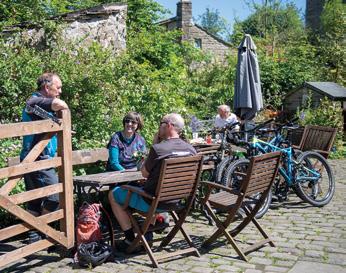
While justifiably proud of the tourist industry in Wales and recognising its capacity to grow, Welsh Government is fully aware that its growth: “…must serve to sustain –not threaten – the things that matter most. That we need to work together in a way that supports the wellbeing of the strengths that bring people here in the first place –our landscapes, culture and adventure.” 25
Cycling & the tourist economy
A decade ago, a European Parliament report reckoned that there were already about 1.23 million overnight cycle trips in the UK, contributing almost half a £billion to the economy.27
The Welsh economy reaps the benefits too: a 2014 report commissioned by Visit Wales estimated that all types of outdoor activity tourism, including cycling, brought in £481m annually, amounting to 6% of the total generated by all tourism in the country.28
Breaking this down, the report states that the contribution from domestic overnight trips (£236m) is similar to the yield from day trips (£220m), with trips from overseas visitors adding £24m.
More recently, Cycling UK’s off-road ‘Rides of Way’ survey found that when travelling away from home to ride:
• Accommodation was respondents’ biggest outlay, with around 29% spending between £50-£100, and 13% £100+. Campsites, B&Bs and independent hotels were the most popular; and

• On a typical ‘away’ visit, just over half spent £10-£50 on food and drink (25% £10-20/28.5% £20-£50).29
Our survey also revealed that Wales’ bike parks are a big draw for visitors from other UK nations – over half had taken a trip away from home to ride there.
The difficulties involved in balancing economic growth with sustainability is acutely felt in Wales’ three National Parks, which all play a pivotal role in both managing the environment and encouraging visitors to enjoy the outdoors.26
Managed well, cycling could help the industry and the National Park Authorities strike the balance between economic growth and Wales’ wider well-being, not least by delivering health benefits (see section above) and sustainability.
2. Motivation two: boosting Wales as a “tourism destination and a magnet for walkers, cyclists and thrill-seekers”
Page 10
Trails for Wales: We can’t afford to wait cyclinguk.org
The yield from connected & promoted routes
Evidence also shows that developing and promoting well-connected routes makes economic sense:
£547m
In 2014, coastal walking in Wales generated £547m in direct expenditure, with a large proportion of walks involving the 870-mile (1,400 km) Wales Coast Path (WCP)30
112
full-time equivalent jobs created along the coast path, according to 2013 estimates31
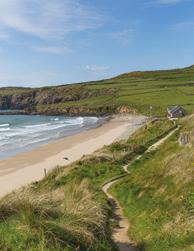
96% of visitors describe the path as enjoyable, and it has helped boost 88% of its visitors’ appreciation of Wales and its culture
£83.40
HOTEL
is the average amount spent per day on accommodation, food and drink33 based on recent data from Cycling UK’s King Alfred’s Way route in southern England. Indeed, many local businesses along this 218-mile (350 km) loop have embraced the boost in passing trade:

Joe Wood, master brewer at Craft Brews UK in Surrey, told us: “We love the camaraderie of the cycling community. Their presence all adds to the vibe and helps bring the brewery alive.” A neighbouring cheesemaker has even created a commemorative cheese for the route, known as ‘King Alfred’s Yellow Jersey’.
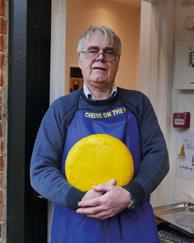
Page 11
The downside of being a tourist magnet & how more cycling helps
Wales is “… most likely to be associated with ‘scenic countryside and villages’ and ‘wilderness and nature’”, 34 with some destinations traditionally drawing a substantial proportion of tourists.
Healthy outdoor activities such as walking, cycling and golf etc. are popular with day-trippers – Gwynedd beats all other local authorities with 20% of visitors engaging in this kind or pursuit.35 This is all to the good, but what isn’t so good is the way that far too many visitors get there: by car.
The traffic management report for Snowdonia National Park, for example, states:
“…the current over reliance on cars to access key honeypot sites and the chronic parking problem at busy times of year is failing the National Park’s core purposes. It also means that local communities and the local economy suffer negative impacts associated with visitor levels, whilst not receiving as much benefit as they could.” 36
Snowdonia isn’t alone. All three National Parks suffer from the negative impact of visitors’ car dependency, especially during the peak seasons.37
It goes without saying that one of the best cures is to encourage and facilitate car-free tourism instead, an objective that upgrading Wales’ deal for off-road cycling (or cycling in combination with public transport) is tailormade to help meet.

Firstly, it’s possible to reach and explore more territory in any given time by bike than on foot, provided the cycling network is coherent and logical; and, secondly, cycling can disperse visitors more widely into the countryside, meaning that opening more paths to bikes would almost certainly help alleviate ‘honeypot’ congestion, and ease the pressure on people who live and work in surrounding communities.
Inevitably, some communities will worry about conflict on local, multi-use paths should the number of people accessing them surge. The solution lies in following Scotland’s lead on an Outdoor Access Code,38 a move that’s helped make the progressive Land Reform Act 2003 such a success story.
25 Welsh Government. Welcome to Wales: Priorities for the visitor economy 2020–2025.
26 Audit Wales: Sustainable Tourism in Wales’ National Parks. July 2022
27 Weston, R, Davies, N, Lumsdon, L & McGrath, P. The European Cycle Route Network: EuroVelo Study European Parliament. 2012
28 White, S & Smith, M. The Economic Impact of Outdoor Activity Tourism in Wales. Visit Wales. 2014
29 Cycling UK. Rides of Way. 2017
30 McDonough, S & Roche, N. The Economic Impact of Coastal Walking in Wales. Evidence Report No 171. Natural Resources Wales. 2016
31 Natural Resources Wales. Evaluating the benefits to business of the Wales Coast Path. 2013
32 Wales Coast Path 10th Anniversary media pack (2022).
33 Cycling UK. King Alfred’s Way.
34 Welsh Government. Visit Wales Tourism Market Demand Report
– UK June 2022.
35 ONS. Sub-National Tourism: A spatial classification of areas in England and Wales to show the importance of tourism, at county and unitary authority level, 2011 to 2013. 2015. This report found that a fifth (20%) of day visitors to Gwynedd (Snowdonia) enjoyed an outdoor activity such as walking, cycling, golf etc.; 15.5% of day visitors to Powys (the site of
Brecon Beacons) and 15% to Denbighshire did the same. About 10%-12.5% of day visitors to seven other local authority areas also went there for an outdoor leisure activity.
36 Yr Wyddfa Partnership. Yr Wyddfa and Ogwen Transport and Parking Review and Options Appraisal. 2020
37 Audit Wales: Sustainable Tourism in Wales’ National Parks.
July 2022
38 The Scottish Outdoor Access Code. See also: Sustrans’ Advice on using shared-use paths; British Horse Society/ Cycling UK’s ‘Be Nice, Say Hi! Campaign; and Cycling UK’s code for mountain bikers.
Page 12
Cycling can disperse visitors more widely into the countryside, meaning that opening more paths to bikes would almost certainly help alleviate ‘honeypot’ congestion.
3. So what’s suppressing cycling in the countryside?
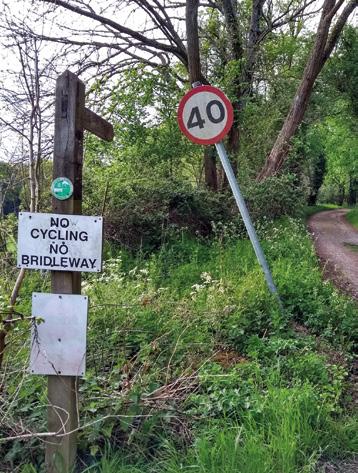
Sticking to byways, bridleways and any permissive paths that allow cycling – which is what cyclists currently have to do – makes for a patchy, inconsistent and frustrating experience.

We know that cycling in the countryside is not nearly the unproblematic fun it could and should be. Our ‘Rides of Way’ survey found that:
80% of respondents said that it was ‘often’ or ‘sometimes’ difficult to put together a ‘legal’ route on the existing rights of way network
75% felt that the rights of way network is not suitable for modern cycle use
Patchiness and inconsistency produce all sorts of barriers and undesirable side-effects.
39 Cycling UK. Rides of Way. 2017 40 Cycling UK press release: Britain’s potential cyclists put off cycling due to traffic conditions and potholes. 31 May 2018 41 National Survey for Wales. Transport question. 42 Future Generations Commissioner for Wales. Transport Fit for Future Generations. September 2018 Page 13
Limited market
The disjointedness of the rights of way network for cycling means that much of it only attracts the ultra-fit and confident, especially mountain-bikers seeking technical and demanding terrain.
Putting together coherent routes for the gentler, but often no less thrilling, type of riding experience can be fraught. It’s particularly provoking, for instance, to come across a perfectly cycle-able, but forbidden, footpath one minute, and a taxing byway or bridleway the next.
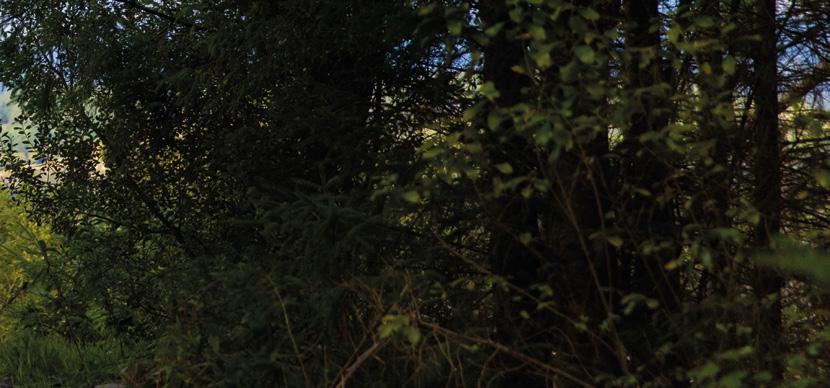
Also, many tracks on CRoW access land enjoy a ‘right to roam’ for walking but no official right for cycling, despite being wide, well-surfaced and ideal for all-ability riders. All this can prove too much of a hurdle for families, disabled people, those who want to ease themselves into cycling more regularly and, indeed, those who are not (yet) after a shot of adrenaline. Certainly, keeping so much of the countryside out of bounds for all-ability cycling is a shame now that tackling hills and longer distances is a growing possibility for a wider range of individuals, thanks to electrically-assisted cycles (e-bikes). At the moment, though, the Welsh countryside fails to cater comprehensively for the full spectrum of cycling experiences that appeal to different people, or to the same people at different phases of their lives: pootles along ‘easy access’ paths; multi-day treks following coherent long-distance routes; or challenging expeditions out in the rugged wilds.
It can also hinder Welsh businesses from realising their full potential. Kath Goodey runs a mountain bike guiding company near Betws-y-Coed and coaches women to build their confidence and skill level on technical descents. Sadly, she says, “some trips prove difficult to deliver in Wales due to the lack of suitable terrain which we can legally access, because there are few logical loops on challenging enough bridleways. So, I have a fully booked trip of 14 riders and we are using the MTB paradise of the Tweed Valley in the Scottish Borders instead of my home valley. I find it heartbreaking that I have to run trips such as this in Scotland when the accommodation, cafés, restaurants and bike shops of my own local area could benefit.”
Scary bits
Sometimes there’s no choice but to cycle along intimidating roads to get to and from the available off-road network, or being repeatedly forced back onto them because rights of way are so disconnected.
The thought of hostile road conditions can be very daunting: a YouGov survey commissioned by Cycling UK, for example, found that nearly three-fifths (59%) of respondents in Wales were put off from cycling by ‘Drivers overtaking too closely to me’, with the same percentage selecting ‘Having to share the road with lorries and other large vehicles’.40
Coerced driving (or not going)
Scary road sections and/or lack of connectivity only serve to coerce many people – residents and tourists alike –to drive into the countryside if they want to experience it, park up and take it from there (thus contributing to the ‘honeypot’ problems discussed in section 2 above).
This freezes out the 12% of people in Wales who don’t have a car (or van) normally available to them or members of their household41 – a figure likely to be higher in poorer communities.42
In fact, the thought of facing known and unknown strife during trips made by sustainable and/or active transport to access greenspace hardly helps those who could, but would rather not for environmental or other reasons, resort to driving. It is, of course, essential to improve public transport in rural and other areas and for the current bus reform proposals to facilitate bus-cycle journeys for both leisure and utility journeys, but cycling for the whole trip is an especially sustainable, healthy and immersive way to engage with the countryside on the doorstep or further afield, and ought to be facilitated, not hampered.
Page 14
We know that cycling in the countryside is not nearly the unproblematic fun it could and should be.
4. Why is the network so patchy & inconsistent for cycling?
Currently, creating or upgrading paths for cycling has to be done one-by-one, right of way by right of way, with the process relying on knotty, plodding legal mechanisms.
As the Minister said in 2019:
“The complex nature of the existing legislation has been one of the triggers for reform”.43
Whether local authorities are willing and able to use it or not, existing legislation certainly does not make it at all straightforward for them to enhance their local rights of way network for cycling, principally because they can only do so on a case-by-case basis.
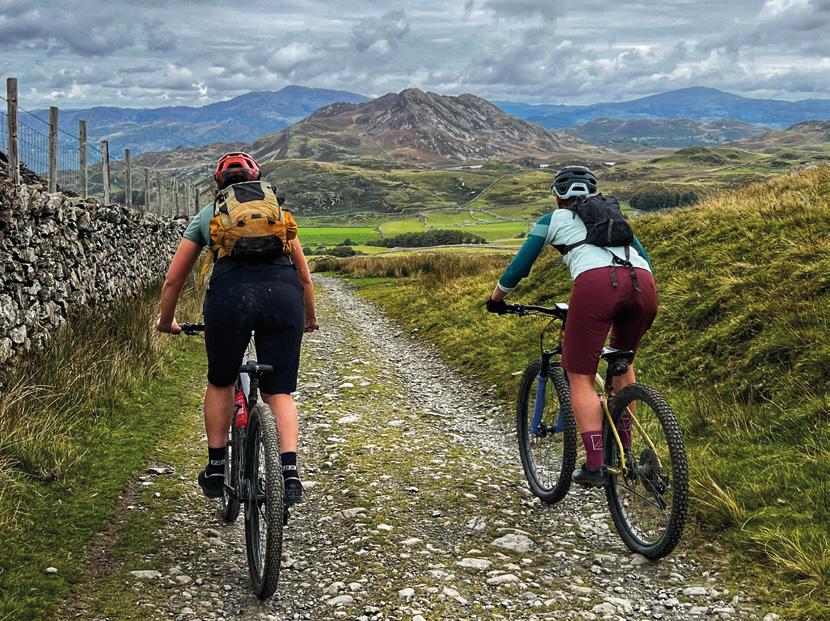
And, although authorities have a duty to produce a Rights of Way Improvement Plan to identify and prioritise access improvements under CRoW, there is no duty to implement it and, in any case, many lack the resources to do so.
Rendering up the rights of way network to far more cycling has consequently long been, and continues to be, a glacial process: an FOI investigation in England by Cycling UK found that between 2009–2019, on average councils created or upgraded less than one new right of way per year for cycling44, and anecdotal evidence suggests that the picture in Wales is equally slow.
43 Welsh Government. Written Statement on taking forward access proposals. 4 April 2019 44 Cycling UK press release: Councils failing to improve public’s access to the countryside. 21 January 2021 Page 15
Trails for Wales: We can’t afford to wait cyclinguk.org

